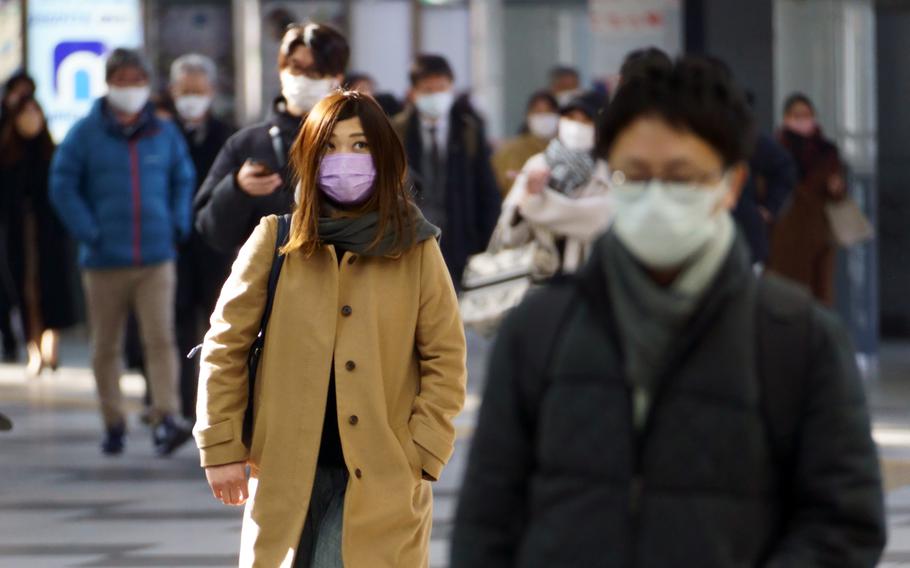
Japan reported a new one-day pandemic high of 84,795 infections on Saturday, Jan. 29, 2022. (Akifumi Ishikawa/Stars and Stripes)
TOKYO — The U.S. military population in Japan awoke Monday to something closer to normal life after three weeks confined to their homes and military bases to stem the tide of COVID-19.
A stay-at-home order imposed by U.S. Forces Japan at the behest of Japan’s government expired at 6 a.m., but some restrictions still apply as tens of thousands of people continue to contract COVID-19 on a daily basis across the country.
Ski trips, shopping excursions, restaurant dining — those activities and then some are back on the free-time agenda for the more than 55,000 U.S. service members, their families and civilian employees in Japan. Masks are still required on and off U.S. bases.
However, restrictions on travel in Japan vary from one U.S. base to another, specifically according to vaccination status. Vaccination rates among uniformed personnel are above 95%, based on statements by individual commands.
Camp Zama, headquarters of U.S. Army Japan, has a 93-mile liberty limit. The Marine Corps sets quarantine requirements for zones and travelers based on vaccination status.
Meanwhile, Japan continues to wrestle with high numbers of new COVID-19 cases each day.
Tokyo reported another 11,751 individuals tested positive Monday, 15,895 on Sunday and 17,433 on Saturday, according to public broadcaster NHK and metro government data online.
Japan reported a new one-day pandemic high of 84,795 infections on Saturday, according to the Johns Hopkins Coronavirus Resource Center.
Tokyo, three surrounding prefectures that make up the greater metro area and nine other prefectures are under a quasi-emergency until Feb. 13, restrictions that close restaurants and bars early and curtail sales of alcohol. The same emergency in 21 other prefectures, including Kyoto, Osaka and Okinawa, expires Feb. 20.
Japan’s Prime Minister Fumio Kishida will not consider stiffening the emergency in Tokyo even as nearly 48.5% of the hospital beds set aside for routine COVID-19 patients are filled, according to Kyodo News. Nearly 5% of those reserved for severely ill patients are filled, an increase from 3.5% a week ago, according to metro data.
On Saturday, its most recent update as of 5:30 p.m. Monday, U.S. Forces Japan reported 283 new COVID-19 cases at 17 installations across Japan, including 26 individuals awaiting confirmation. The total is one less than the previous report on Friday.
At U.S. military bases in Japan, service members, civilian employees and their families may again venture beyond the gates for more than groceries, worship services and medical appointments. A 10 p.m. to 6 a.m. curfew is also lifted, although local curfews and a standing curfew for some service members in Japan still apply.
One significant change also arrived Monday: The period of restricted movement — a loose quarantine for anyone returning to Japan from travel overseas — was halved by some military commands in Japan from 14 days to seven. That keeps with the change made by the Japanese government last week.
U.S. Naval Forces Japan, Yokota Air Base in western Tokyo and Kadena Air Base on Okinawa all require the seven-day quarantine period for fully, partially and unvaccinated travelers, according to their Facebook pages. However, unvaccinated individuals are required to spend more time at home, according to rules set by their commands and posted on official base Facebook pages.
III Marine Expeditionary Force still required 14 days of post-travel restricted movement, according to its Facebook page Monday.
The omicron phase of the pandemic on Okinawa may be weakening, but case numbers on the island are still high, according to a III MEF Facebook post Saturday.
Okinawa prefecture, where III MEF is headquartered and Kadena is located, reported 480 new COVID-19 cases Monday, 838 on Sunday and 979 on Saturday, according to the prefectural Department of Public Health and Medical Care.
The prefecture also reported 98 cases from the U.S. military Monday, 89 on Sunday and 225 on Saturday.
Kadena, with a population greater than 18,000, reported 317 active cases Friday, its lastest update, and 25 new cases Saturday and 49 on Friday, according to USFJ.
Okinawa Gov. Denny Tamaki was less optimistic than III MEF about the end of home confinement. On Sunday he tweeted a message on the prefectural Twitter account: “Okinawa Prefecture is still under quasi-emergency, and it is difficult to say that US military is in a good enough condition to lift the restrictions on their activities outside bases.”
Stars and Stripes reporter Mari Higa contributed to this report.